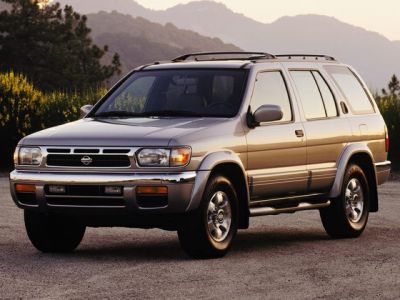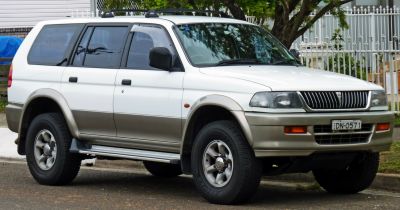 2001 Nissan X-Trail I (T30) Dimensions, Size & Specs
2001 Nissan X-Trail I (T30) Dimensions, Size & SpecsMeasurements of the 2001 Nissan X-Trail I, engineered for optimal performance and comfort
| Dimensions | |
|---|---|
| Length: | 4510 mm177.6 in14.8 ft |
| Width: | 1765 mm69.5 in5.8 ft |
| Height: | 1675 mm65.9 in5.5 ft |
| Trunk Capacity: | 410 liter14.5 cu ft |
| Trunk Capacity (Max): | 1841 liter65.0 cu ft |
| Weight Specifications | |
| Curb Weight: | 1445-1534 kg3186-3382 lbs |
| Maximal permitted Weight: | 2000-2050 kg4409-4519 lbs |
| Roof Load: | 100 kg220 lbs |
| Tire Specifications | |
| Rims Sizes: |
|
| Tire Sizes: |
|
The Nissan X-Trail I (T30), produced between 2001 and 2003, represents Nissan's entry into the compact SUV segment with a practical and versatile design. Measuring 4510 mm (177.6 inches) in length, 1765 mm (69.5 inches) in width, and 1675 mm (65.9 inches) in height, this SUV provides balanced exterior dimensions that suit both urban driving and off-road capabilities. The curb weight ranges between 1445 kg and 1534 kg (3187 to 3382 lbs), offering a solid but manageable vehicle mass for its class. The maximum allowable weight for this generation varies between 2000 kg and 2050 kg (4409 to 4519 lbs), supporting a good load capacity that complements its SUV utility. Luggage space is a standout feature, with a standard cargo volume of 410 liters (14.5 cubic feet) behind the rear seats, expanding impressively to 1841 liters (65 cubic feet) when the rear seats are folded down. This provides ample room for family trips or transporting bulky items, a key advantage for many SUV buyers. Its roof load capacity is rated at 100 kg (220 lbs), enabling additional storage options such as roof boxes or sporting equipment. The X-Trail I rides on 15- or 16-inch rims, paired with tire sizes including 215/65 R16, 215/70 R15, and 215/70 R16, which support its versatility in various driving conditions. Overall, the Nissan X-Trail I (T30) is a practical and dependable compact SUV from the early 2000s, combining respectable dimensions, flexible interior space, and a robust build suited for everyday use and adventurous outings.
Discover the standout features that make the 2001 Nissan X-Trail I a leader in its class
Have a question? Please check our knowledgebase first.
The Nissan X-Trail I (T30), produced between 2001 and 2003, measures 4510 mm (177.6 inches) in length, 1765 mm (69.5 inches) in width, and stands 1675 mm (65.9 inches) tall. These dimensions place it firmly in the compact SUV category, offering a balance of road presence and maneuverability. Its size allows for comfortable passenger and cargo space while still being easy enough to handle in urban environments and tight parking spaces.
The Nissan X-Trail I (T30) has a curb weight ranging between 1445 kg to 1534 kg (3187 to 3381 lbs), depending on the specific configuration and equipment. Its maximum weight capacity is between 2000 kg and 2050 kg (4409 to 4519 lbs). This weight range gives the vehicle a solid, stable feel on the road while enabling it to handle moderate loads without compromising handling or fuel efficiency. The difference between curb and maximum weight includes passengers, cargo, and any additional equipment or accessories.
The Nissan X-Trail I (T30) offers a practical cargo capacity of 410 liters (approximately 14.5 cubic feet) with the rear seats in place, making it suitable for everyday luggage, groceries, or smaller outdoor gear. When the rear seats are folded down, the cargo space expands dramatically to 1841 liters (about 65 cubic feet). This provides ample room for larger items like sports equipment, furniture, or luggage for longer trips, making the vehicle highly versatile for different lifestyle needs.
The Nissan X-Trail I (T30) should fit comfortably within a standard residential garage, as its overall length is 4510 mm (177.6 inches), width 1765 mm (69.5 inches), and height 1675 mm (65.9 inches). Standard garages typically accommodate vehicles up to about 6 meters (around 236 inches) in length and 2.5 meters (98 inches) wide, so this SUV’s compact size will allow easy parking and maneuvering inside typical garage spaces without issue.
The roof load capacity of the Nissan X-Trail I (T30) is 100 kg (220 lbs). This weight limit allows for the safe mounting of roof racks, cargo boxes, bikes, or small kayaks. It's ideal for outdoor enthusiasts who need extra storage space for gear during trips. However, it’s important to ensure that roof cargo is properly secured and evenly distributed to avoid negatively affecting handling and fuel economy.
The Nissan X-Trail I (T30) came with multiple tire and rim size options to suit different driving styles and conditions. Rim sizes available include 15-inch and 16-inch variants. Tire sizes ranged from 215/65 R16, 215/70 R15, to 215/70 R16. These setups offer a good balance between ride comfort, grip, and durability, providing confident handling on both city roads and light off-road surfaces.
The Nissan X-Trail I (T30) was the first generation of the X-Trail model, launched in 2001, so it does not have a predecessor X-Trail generation. However, compared to the previous Nissan Terrano II and other Nissan SUVs in its lineup, the T30 was designed with more urban and family-friendly dimensions that offered better maneuverability and more modern styling, making it a fresh addition to the Nissan compact SUV segment.
In the early 2000s, the Nissan X-Trail I (T30) was competitive in the compact SUV segment. With a length of 4510 mm (177.6 inches) and width of 1765 mm (69.5 inches), it was similar in size to competitors like the Toyota RAV4 and Honda CR-V of that era. While slightly taller at 1675 mm (65.9 inches), the X-Trail offered comparable passenger space but often featured more rugged SUV styling and off-road capability, providing a unique blend of city and adventure appeal.
While specific ground clearance values for the Nissan X-Trail I (T30) vary based on trim and suspension setup, it generally offers around 200 mm (7.9 inches). This clearance, combined with features like available all-wheel drive and robust chassis design, gives it moderate off-road capability suitable for light trails, gravel roads, and adverse weather. The balance between off-road potential and everyday usability made the T30 popular among drivers seeking versatility.
The Nissan X-Trail I (T30) targeted consumers looking for a compact SUV capable of handling both city driving and light off-road excursions. It featured practical interior space, flexible cargo capacity, and rugged styling. Designed for families, outdoor enthusiasts, and active individuals, it combined comfort with utility. Known for reliability and ease of driving, it was well received in markets seeking versatile, affordable SUVs in the early 2000s.
Discover similar sized cars.

| Production: | 1995-2002 |
|---|---|
| Model Year: | 1995 |
| Length: | 4520 mm178.0 in |
| Width: | 1750 mm68.9 in |
| Height: | 1675-1710 mm65.9-67.3 in |

| Production: | 1995-2004 |
|---|---|
| Model Year: | 1995 |
| Length: | 4530-4640 mm178.3-182.7 in |
| Width: | 1820-1840 mm71.7-72.4 in |
| Height: | 1750-1800 mm68.9-70.9 in |

| Production: | 1996-2001 |
|---|---|
| Model Year: | 1996 |
| Length: | 4530 mm178.3 in |
| Width: | 1775 mm69.9 in |
| Height: | 1730 mm68.1 in |
